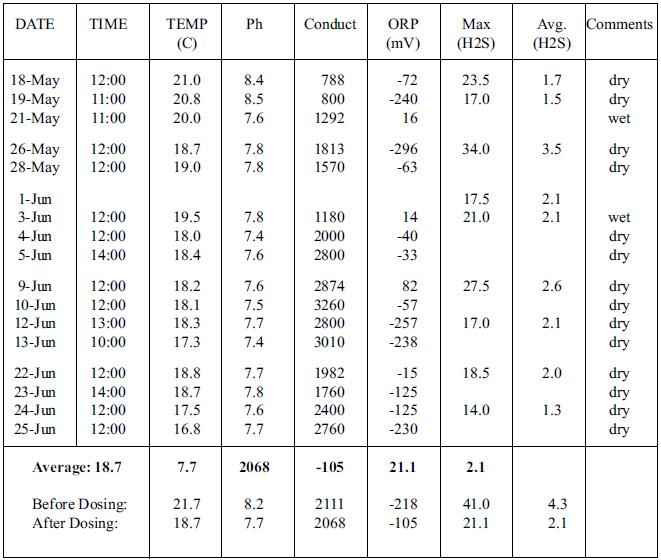
Case Study: Water Board
Australia
July 6, 1992
INDUSTRY:  MUNICIPAL
MUNICIPAL
CLIENT:  WATER BOARD
WATER BOARD
OBJECTIVE: To Significantly Reduce Hydrogen Sulfide Odour
SUMMARY
In March, 1992, the Water Board implemented a biological inoculation procedure which was
designed to significantly reduce the production of Hydrogen Sulfide gas (and the associated
odour with septicity problems) at two pumping stations.
The inoculation program, which utilizes an anaerobic inoculant was commenced on 5/14/92, has
eliminated the existing odour problem, and has eliminated the need for pumping station cleaning.
BACKGROUND
• Pumping station 1 discharges about 0.5 megalitres per day of domestic sewage, to pumping
station 2, which is sited adjacent to a small private school.
• Pumping station 2 is ventilated by a vent stack which is located very close to the school
classrooms.
• There has been ongoing complaints from the school regarding severe sulfide odour.
• The odour is attributed to long rising main retention times, and salt water intrusion. The
resultant anaerobic environment typically promotes the production of sulfides.
SOLUTION
Insitu:
It was acknowledged that the odour was being produced as a result of the biological environment
which existed within the pumping station and rising mains. In order to prevent this odour being
produced, a specialized anaerobic inoculant was used.
The product is a specially formulated anaerobic biological inoculant, designed to prevent the
production of sulfide odour, as well as removing and preventing the accumulation of grease,
sludge and sulfide slime deposits.
PROCEDURE
In order to quantify the problem, a monitoring program was established, to determine (among
other things) the concentration of Hydrogen Sulfide gas generated in the wet well of SPS 510
(the source of the odour complaints).
An EXOTOX 75 gas sampler/analyzer was used for this purpose. This device was installed in
the pumping station wet well, and obtained and analyzed gas samples every minute over a 12
hour period on each sampling day.
Sampling was undertaken for a two-week period prior to dosing, and then 2 to 3 days per week
during dosing.
RESULTS
Hydrogen Sulfide Gas
• Analysis results confirmed the presence of high concentrations of Hydrogen Sulfide Gas each
time the pumping stations operated, with a typical daily peak (before dosing) of between 40
ppm and 50 ppm Hydrogen Sulfide Gas.
• Immediately following the commencement of dosing, the concentration of Hydrogen Sulfide
gas was reduced to between 20 ppm and 30 ppm. After 7 weeks of dosing, the level of
Hydrogen Sulfide Gas was reduced to between 3 ppm and 8 ppm.
• Since dosing began, peak and average Hydrogen Sulfide Gas concentrations have reduced by
half (and continue to fall), as has ORP (refer to results in the following summary).
Odour Complaints
• Prior to dosing, several odour complaints were registered each day from the school staff.
• Since dosing began, there have been no odour complaints from the school staff, who are
quoted as being “ecstatic” about the improvement.
SPS Grease
• Prior to dosing, both pumping stations required cleaning (accumulated grease, etc.) every 2 to
3 weeks.
• Since dosing commenced, both pumping stations have remained spotlessly clean and free of
odour and have not required cleaning, (after 7 weeks).
• Pumping station maintenance staff are quoted as being, “delighted” and report that the stations
look “brand new, as though they have been cleaned with a Gerni”.
Conclusion:
The program inoculation has been shown to achieve excellent results in preventing odour,
septicity and grease accumulation in sewage pumping stations. The procedure is very easily
adopted, uncomplicated, and extremely cost-effective.
AFTER DOSING

Contact Us
Phone: 541-388-4546
Email: drsenviro@gmail.com